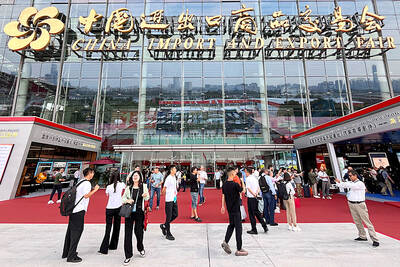Automakers seem to be a little frantic these days. At this season's major auto shows in Detroit, Chicago, Geneva and New York, they offered vehicles powered by diesel fuel, hybrid systems and ethanol, massive pickups and tiny subcompacts, nostalgic muscle cars and futuristic crossovers.
Finding the right formula to whet car buyers' appetites has become more essential than ever. Automakers are responding with more products to fill every niche, which is a boon for consumers but painful and expensive for US automakers.
High gasoline prices also intensify the risks for General Motors Corp and Ford Motor Co, whose operating profits come primarily from less-fuel-efficient pickup trucks and sport utility vehicles.

PHOTO: AP
"There's a lot of things GM and Ford are still grappling with if they're going to adapt to these niche markets," said Erich Merkle, director of forecasting for the consulting firm IRN Inc. "They can be profitable, but they're going to have to change the entire way they do business."
In a recent speech, Ford's Americas president Mark Fields said there will be 300 nameplates in the US market by the end of the decade, up from 215 in 2002. The explosion is apparent at the auto shows. In Detroit alone, 33 vehicles made their worldwide debuts.
Japanese and South Korean automakers are better equipped to make many different models because they have lower labor costs and newer, more flexible plants that can build multiple products on the same line.
When Honda Motor Co found its Ridgeline pickup was not meeting sales targets, it ramped up production of more popular vehicles like the Odyssey minivan made at the same plant, Merkle said.
Ford and GM are working on making their operations leaner, by cutting thousands of jobs, closing plants, and using the same underpinnings on multiple vehicles, but it will take time before they can match the level of their rivals.
Fields said this past week that Ford expects 82 percent of its assembly facilities to be flexible by 2008, up from 38 percent in 2004.
Meanwhile, they'll be facing a product juggernaut from more nimble companies. At the New York show last week, Hyundai Motor Co launched its seventh totally redesigned product in 24 months.
"There seems to be something for everyone. Automakers are slicing the pie even narrower," said Jack Nerad, editorial director of Kelley Blue Book, an auto information service, as he roamed the New York show, which opened to the public on Friday.
Against a backdrop of high gas prices, fuel-saving technologies were big at this year's shows. Jim Sanfilippo, a senior industry analyst with Michigan-based Automotive Marketing Consultants Inc, said the hybrid-electric system on the new Lexus LS600h is one of the most advanced inventions he has ever seen.
The 600h, which debuted at the New York show and goes on sale next year, is billed as a luxury performance sedan, with a V8 engine that performs more like a 12-cylinder when it's coupled with hybrid-electric power.
But Nerad said it's uncertain if high-performance hybrids will catch on with consumers, who are not accustomed to viewing hybrids as horsepower boosters. It's a debate that highlights the risk for automakers in a time of rapidly changing technology.
That's why automakers are placing bets on different technology. In Detroit, Ford rolled out a diesel-electric hybrid concept that it says can achieve 104km per gallon. Mercedes-Benz promoted its Bluetec diesel engine, which will meet emissions regulations in all 50 US states once ultra-low-sulfur diesel comes on the market this fall. Vehicles powered by corn-based ethanol got an unusual amount of attention as a viable technology that's already on the road.
At the Chicago show, GM and Ford announced plans to convert more fuel pumps to ethanol and educate the owners of the 6 million ethanol-capable vehicles on the road about the benefits of the fuel, which contains only 15 percent gasoline.

SECURITY: As China is ‘reshaping’ Hong Kong’s population, Taiwan must raise the eligibility threshold for applications from Hong Kongers, Chiu Chui-cheng said When Hong Kong and Macau citizens apply for residency in Taiwan, it would be under a new category that includes a “national security observation period,” Mainland Affairs Council (MAC) Minister Chiu Chui-cheng (邱垂正) said yesterday. President William Lai (賴清德) on March 13 announced 17 strategies to counter China’s aggression toward Taiwan, including incorporating national security considerations into the review process for residency applications from Hong Kong and Macau citizens. The situation in Hong Kong is constantly changing, Chiu said to media yesterday on the sidelines of the Taipei Technology Run hosted by the Taipei Neihu Technology Park Development Association. With

CARROT AND STICK: While unrelenting in its military threats, China attracted nearly 40,000 Taiwanese to over 400 business events last year Nearly 40,000 Taiwanese last year joined industry events in China, such as conferences and trade fairs, supported by the Chinese government, a study showed yesterday, as Beijing ramps up a charm offensive toward Taipei alongside military pressure. China has long taken a carrot-and-stick approach to Taiwan, threatening it with the prospect of military action while reaching out to those it believes are amenable to Beijing’s point of view. Taiwanese security officials are wary of what they see as Beijing’s influence campaigns to sway public opinion after Taipei and Beijing gradually resumed travel links halted by the COVID-19 pandemic, but the scale of

A US Marine Corps regiment equipped with Naval Strike Missiles (NSM) is set to participate in the upcoming Balikatan 25 exercise in the Luzon Strait, marking the system’s first-ever deployment in the Philippines. US and Philippine officials have separately confirmed that the Navy Marine Expeditionary Ship Interdiction System (NMESIS) — the mobile launch platform for the Naval Strike Missile — would take part in the joint exercise. The missiles are being deployed to “a strategic first island chain chokepoint” in the waters between Taiwan proper and the Philippines, US-based Naval News reported. “The Luzon Strait and Bashi Channel represent a critical access

Pope Francis is be laid to rest on Saturday after lying in state for three days in St Peter’s Basilica, where the faithful are expected to flock to pay their respects to history’s first Latin American pontiff. The cardinals met yesterday in the Vatican’s synod hall to chart the next steps before a conclave begins to choose Francis’ successor, as condolences poured in from around the world. According to current norms, the conclave must begin between May 5 and 10. The cardinals set the funeral for Saturday at 10am in St Peter’s Square, to be celebrated by the dean of the College